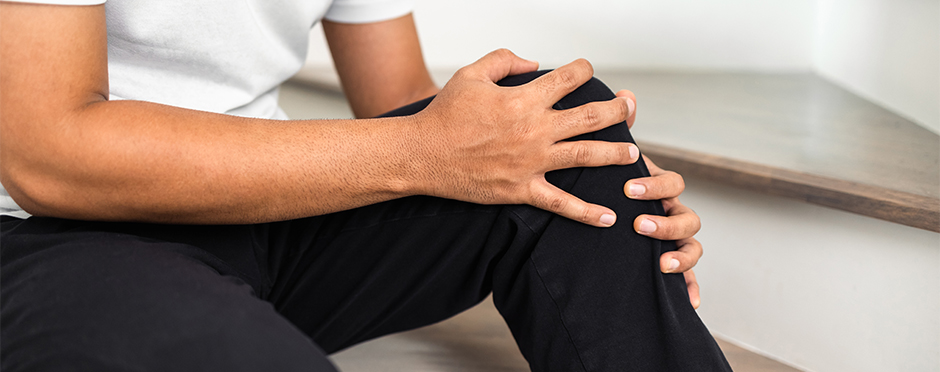
Where Does Your Knee Hurt? What Your Pain Might Be Telling You
Leave a CommentKnee pain is one of the most common diagnoses we treat at Athletico and is among the top three cases I see as an orthopedic physical therapist. According to the Journal of the American Medical Association, around 5% of doctor visits are for knee pain, and physical therapy is one of the primary treatment methods.
While knee pain, in general, is common, there are many different sources or causes of knee pain. In this article, we will explore how the location of your knee pain correlates with a possible injury and what physical therapy may entail for that injury.
Anterior Knee Pain
Pain on the front side of the knee is quite common. Here are some possible reasons:
- Patellofemoral pain syndrome: This is the most common cause of knee pain for active adults under age 401. Typically, a lack of quadriceps or hip strength causes too much force on the knee during activity. Physical therapy will be customized to the individual, but it might include specific leg strengthening or stretching exercises, taping, or even gait retraining for runners.
- Patellar tendinitis: Overuse of the knee can irritate the tendon connecting the kneecap to the shin, resulting in pain. Physical therapy includes activity modification to relieve stress on the patellar tendon and specific stretches or strengthening exercises.
Medial Knee Pain
Pain on the side of the inside knee (facing towards your body’s midline) is also common. Here’s what this pain could mean:
- Knee osteoarthritis (OA): Most prevalent in adults over the age of 40, this indicates a thinning of the cartilage between your femur (upper leg bone) and tibia (lower leg bone). Physical therapy involves strengthening the thigh muscles, manual therapy, and education on proper mechanics and pain control.
- Medial meniscus or MCL injuries: This type of injury usually results from an obvious traumatic event, such as a forceful impact or awkward pivot leading to the injury. The meniscus is a cushion that separates the femur and tibia, while the MCL is a ligament that stabilizes the medial knee. Physical therapy depends upon the extent of the injury, but tends to focus on restoring range of motion, controlling pain or swelling, and regaining strength.
Lateral Knee Pain
Pain on the outside of the knee (facing away from your body) is less common than anterior or medial, but there are still a few reasons you could have pain here:
- ITB pain syndrome: The Iliotibial band (ITB) is a long connective tissue that originates from the outside of our hip and attaches just below the outside of our knee. Runners know this long tissue can cause significant knee pain when aggravated. Physical therapy will address any faulty mechanics or muscle imbalances and gradually reintroduce high-level activities such as running.
- Lateral meniscus or LCL injuries: Similar to the medial side, the lateral side of the knee has a meniscus and a stabilizing ligament (lateral collateral ligament or LCL), both of which can be injured with an obvious collision or forceful twist. Again, physical therapy depends upon the extent of the injury but tends to focus on restoring range of motion, controlling pain or swelling, and regaining strength.
Posterior Knee Pain
Pain on the back side of the knee is least common, but nonetheless can be significant. Here are two possible reasons:
- PCL injuries: The posterior cruciate ligament (PCL) is very similar to the more well-known ACL and performs a similar function. The difference in either the PCL or ACL being affected depends on how the injury occurred. A forceful push backward on the tibia, such as a dashboard in a car accident or a slip and fall, could be more likely to injure the PCL. Commonly, an injury to the PCL or ACL may need surgery. Whether you have surgery or not, physical therapy, in this case, will focus on controlling pain, restoring normal walking or running mechanics, and preventing future injuries.
- Baker’s cyst: This is a fluid-filled sac that can form in the posterior pocket of the knee. It is most often associated with people with an inflammatory condition such as arthritis or knee hyperextension. Most often, it does not require treatment, as most will resolve on their own. However, in more severe cases, physical therapy will focus on reducing leg swelling and preserving knee function2.
If knee pain is keeping you from living an active life, reach out to one of our movement experts. They can assess your current condition and recommend the best treatment plan for your needs! Free assessments are available in-clinic and virtually through our telehealth platform.
*Per federal guidelines, beneficiaries of plans such as Medicare, Medicaid, Tricare, VHA and other federally funded plans are not eligible for free assessments.
The Athletico blog is an educational resource written by Athletico employees. Athletico bloggers are licensed professionals who abide by the code of ethics outlined by their respective professional associations. The content published in blog posts represents the opinion of the individual author based on their expertise and experience. The content provided in this blog is for informational purposes only, does not constitute medical advice and should not be relied on for making personal health decisions.
References:
1. Duong, Vicky et al. “Evaluation and Treatment of Knee Pain: A Review.” JAMA vol. 330,16 (2023): 1568-1580. doi:10.1001/jama.2023.19675
2. Leib AD, Roshan A, Foris LA, et al. Baker’s Cyst. [Updated 2023 Aug 4]. In: StatPearls [Internet]. Treasure Island (FL): StatPearls Publishing; 2024 Jan-. Available from: https://www.ncbi.nlm.nih.gov/books/NBK430774/
